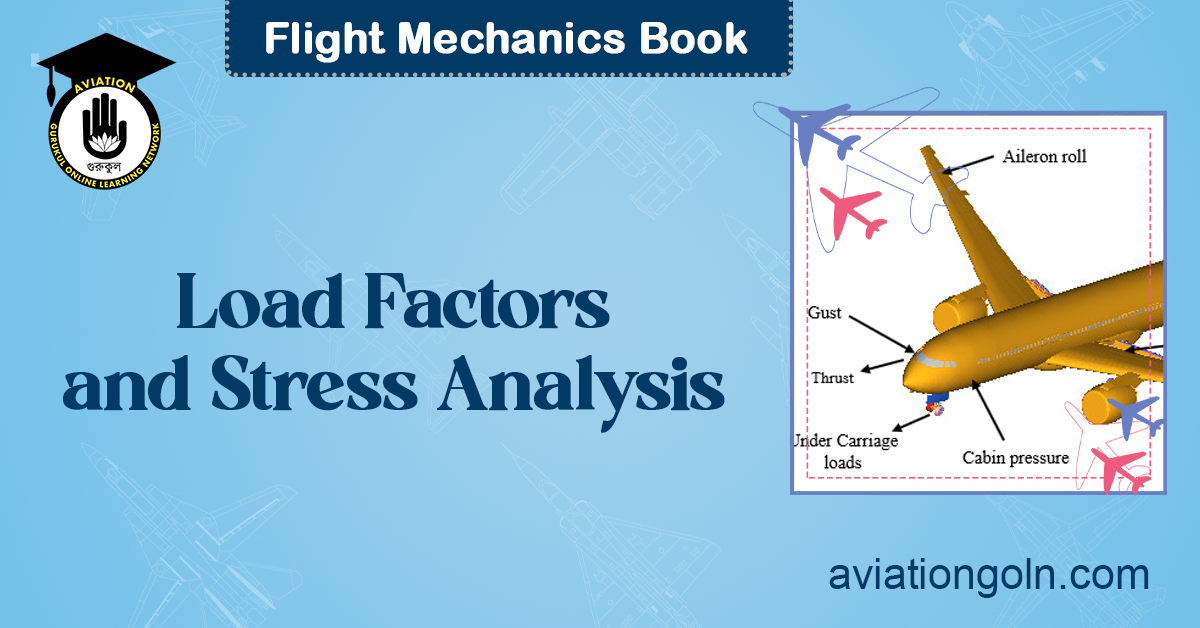Load Factors and Stress Analysis: The primary goal of an aircraft is to provide safe and efficient transportation through the air. To accomplish this, an aircraft’s structure and materials must be meticulously designed to endure the diverse and dynamic forces experienced during flight. This article delves into the principles of load factors, the importance of stress analysis, and the selection of materials for aircraft structures.
Load Factors and Stress Analysis
1. Understanding Load Factors
A load factor, often referred to in the context of ‘g-forces’, is a dimensionless number that represents the ratio of the aerodynamic force experienced by an aircraft to its weight. In essence, it quantifies the stresses that an aircraft will face under various conditions.
- Types of Loads:
- Static Loads: These are constant over time, such as the aircraft’s weight.
- Dynamic Loads: These vary with time, like turbulence or landing impact.
- Operational Load Factors:
- Limit Load Factor: The maximum load factor that an aircraft might be expected to experience once during its service life.
- Ultimate Load Factor: Typically 1.5 times the limit load factor, it is the load that an aircraft structure must sustain without experiencing structural failure.

2. Stress Analysis in Aircraft Design
Stress analysis is an essential phase in aircraft design, ensuring that the structure can sustain the loads it might encounter throughout its operational life.
- Static Stress Analysis: Examines the stresses and deformations in structures under static or slowly varying loads. For instance, the weight of the aircraft or the pressure exerted by fuel in the tanks.
- Dynamic Stress Analysis: Focuses on the stresses caused by rapidly changing loads, such as those induced by wind gusts or rapid maneuvering.

3. Materials in Aircraft Structures
The choice of material for an aircraft structure is driven by factors like strength, weight, durability, and cost.
- Aluminum and its Alloys: Traditionally, aircraft structures, especially the skin, have been made of aluminum due to its excellent strength-to-weight ratio, good ductility, and corrosion resistance.
- Composite Materials: In recent years, there has been a significant shift towards composite materials like carbon-fiber-reinforced polymers (CFRP). These materials offer high strength and stiffness, are lighter than metals, and can be shaped into complex geometries. They are prominently used in modern aircraft like the Boeing 787 and the Airbus A350.

- Titanium: Known for its high strength, low density, and excellent resistance to corrosion, titanium finds its application in aircraft engine components and fasteners.
- Steel: While heavier than aluminum and titanium, steel’s high strength makes it suitable for specific applications like landing gear components.

4. Factors Influencing Material Selection
- Weight: Aircraft efficiency is directly tied to its weight. Lighter materials can lead to significant fuel savings over an aircraft’s operational life.
- Strength: Materials must endure the mechanical stresses experienced during flight, takeoff, landing, and potential emergency scenarios.
- Temperature Resistance: Engines and areas near them require materials that can resist high temperatures.
- Corrosion Resistance: Given that aircraft operate in various environments, materials must resist corrosion from factors like moisture, salt, and industrial pollutants.
- Fatigue Resistance: Repeated stress cycles can lead to material fatigue. Materials for aircraft need to have high fatigue resistance to ensure a long service life.

5. Interaction Between Load Factors and Materials
Understanding the relationship between load factors and materials is crucial for aircraft design. The correct material choice can significantly amplify the aircraft’s capacity to handle higher load factors, ensuring safety and structural integrity.
- Material Behavior under Load: Different materials react differently under load. While metals typically have a linear stress-strain relationship up to their yield point, composites might exhibit non-linear behavior.
- Failure Modes: Understanding how materials fail under different load scenarios is crucial. For metals, it might be yielding or buckling, while composites might face delamination or fiber breakage.
- Factor of Safety: Given the critical nature of aircraft operations, structures are designed with a factor of safety, ensuring that they can handle loads beyond anticipated maximums without catastrophic failure.

6. Modern Innovations in Aircraft Materials
As aircraft design evolves, so does the search for better, more efficient materials.
- Nanomaterials: Incorporating nanoparticles can significantly enhance a material’s properties. For instance, nanocomposites can offer increased strength and stiffness with reduced weight.
- Shape Memory Alloys: These materials can “remember” their original shape and return to it after being deformed, offering potential applications in aircraft structures and systems.
- Bio-Based Composites: To reduce the environmental footprint, there’s a push towards bio-based composites, derived from renewable sources.

Load factors and stress analysis lie at the heart of aircraft design, ensuring that these complex machines can safely navigate the skies. With the rapid advancements in material science, modern aircraft are becoming lighter, stronger, and more efficient. These developments underline the importance of a deep understanding of both the forces an aircraft might experience and the materials from which it’s constructed.
See more:
